Advanced hikers starting on tough terrain must prepare with meticulous planning and skill enhancement. Researching trail conditions through resources like AllTrails can prevent surprises; seasonal changes might transform landscapes dramatically. Skill development in navigation and terrain negotiation is essential; mastering map reading and utilizing GPS guarantees accurate pathfinding. Invest in rigorous physical conditioning through cross-training to build strength, endurance, and agility. Selecting appropriate gear, such as waterproof boots and trekking poles, aids in handling unpredictable environments. Efficient backpack packing improves balance, while understanding techniques for barriers like boulder fields and river crossings is crucial. Gain deeper insights into these strategies further.
Key Takeaways
- Research current trail conditions using resources like AllTrails to ensure safety and preparedness for challenging terrain.
- Develop advanced hiking techniques, such as navigation with topographic maps, to improve outdoor skills and confidence.
- Incorporate strength, balance, and endurance exercises into your fitness routine to enhance stability and stamina on tough hikes.
- Select appropriate gear, including waterproof boots and trekking poles, for stability and joint support on uneven terrain.
- Practice efficient backpack packing by optimizing weight distribution and ensuring easy access to frequently used items.
Research Trail Conditions
Before setting out on a challenging hike, it is vital to thoroughly research trail conditions to guarantee safety and preparedness. Weather impacts play a significant role in altering the landscape, potentially transforming a familiar path into a treacherous journey. Rain can lead to slippery surfaces and mud, while snow may obscure the trail entirely or cause ice formation.
To mitigate these risks, consult reliable resources like AllTrails and local park websites, which offer valuable insights into the current state of trails.
Trail reports are indispensable for advanced hikers, providing firsthand accounts of recent challenges encountered by others. These reports often reveal important information about erosion, fallen trees, or other obstacles not immediately apparent from official resources.
Additionally, reviewing forums and community discussions can offer practical advice on maneuvering specific sections of the trail.
Understanding seasonal changes is also significant. Spring melt-off can result in flooding, demanding heightened caution and potentially altering your planned route.
Select Appropriate Gear

Preparation is the foundation of successful advanced hiking, and selecting appropriate gear is vital to this process. Gear selection begins with choosing the right footwear. Opt for mid-weight, waterproof hiking boots that offer ankle support; confirm boot fitting is precise to avoid blisters and discomfort. Breaking in your boots before tackling tough terrain is important. Complement your boots with trekking poles, which greatly enhance stability and alleviate joint strain, especially on steep ascents and descents.
A well-chosen backpack is essential. Select a lightweight, durable option in the 25-45 liter range for day hikes—this balances capacity with portability, allowing you to carry essentials without excess burden. Include important items such as a first-aid kit, multi-tool, and extra food, making sure you're prepared for unforeseen circumstances.
To withstand extreme weather, prioritize waterproof and breathable outer layers. These will maintain comfort and dryness, allowing you to focus on conquering challenging trails. Below is a concise guide to gear necessities for advanced hiking:
| Gear Component | Key Feature | Purpose |
|---|---|---|
| Hiking Boots | Waterproof, ankle support | Comfort, injury prevention |
| Trekking Poles | Stability | Joint strain reduction |
| Backpack | Lightweight, 25-45L | Carry essentials efficiently |
| First-Aid Kit | all-encompassing | Emergency preparedness |
| Outer Layers | Waterproof, breathable | Weather protection |
Thoughtful gear selection guarantees safety and enhances the hiking experience.
Plan Practice Hikes
Setting out on practice hikes is an essential step in preparing for advanced hiking challenges. Trail selection plays a pivotal role in this preparation process. Opt for trails that progressively increase in difficulty, incorporating diverse terrain types such as steep inclines, rocky paths, and uneven surfaces. This approach not only builds physical endurance but also boosts confidence as you become familiar with the varied challenges of tougher trails.
To guarantee optimal physical preparation, aim for a hike frequency of at least once a week during the month leading up to your challenging adventure. This consistent schedule allows your body to adapt to the increasing demands, while also giving you ample opportunity to acclimate to your gear and refine your packing strategies. Each practice hike should serve as a testbed for adjusting equipment, assuring comfort and functionality.
Furthermore, practice hikes are perfect for honing specific hiking techniques such as pacing and breath control. These skills become vital when maneuvering through tough terrain, allowing you to maintain energy and focus.
Implement Cross-Training
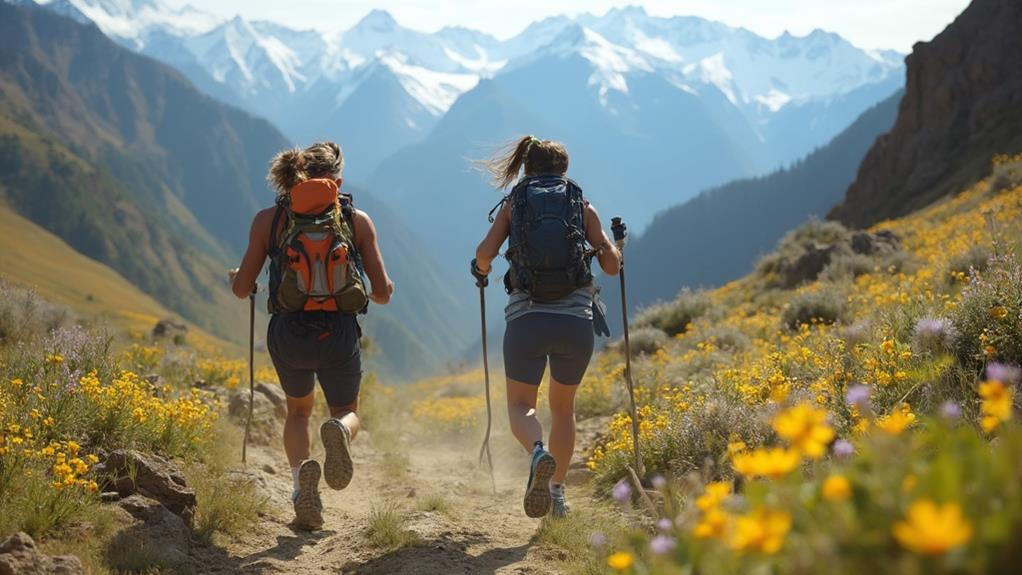
Implementing cross-training into your routine is a strategic approach to enhance your readiness for advanced hiking challenges. Cross training benefits include improved endurance, strength, and flexibility, preparing you to tackle any terrain with confidence. Incorporating exercise variety, such as cardio, strength, balance, and flexibility workouts, guarantees a thorough fitness regime that targets essential aspects of hiking preparedness.
| Exercise Type | Focus Area | Example Activities |
|---|---|---|
| Cardio | Endurance & Stamina | Trail Running, Cycling |
| Strength | Major Muscle Groups | Leg Press, Deadlifts |
| Balance | Stability & Coordination | Balance Board, Bosu Ball |
| Flexibility | Range of Motion | Yoga, Dynamic Stretching |
Cardio activities like trail running or cycling boost stamina, vital for prolonged hikes over rugged landscapes. Strength training, focusing on the legs, core, and lower back, builds the power needed for steep ascents and maneuvering uneven surfaces. Balance exercises on unstable surfaces greatly improve stability and coordination, key for maintaining footing on challenging trails. Finally, flexibility exercises, including yoga, help prevent injuries by enhancing range of motion and reducing muscle tightness.
A well-rounded training regimen, featuring at least two days each of strength and cardio, along with flexibility workouts weekly, maximizes the cross training benefits and optimizes your hiking performance.
Efficient Backpack Packing
Mastering efficient backpack packing is essential for tackling tough terrain, as it optimizes weight distribution and enhances overall hiking performance.
By strategically placing heavy items near your back and waist, you maintain balance and minimize shoulder strain, while organizing frequently used gear in accessible pockets guarantees seamless access on the trail.
Practice hikes offer an opportunity to experiment with packing techniques, allowing you to refine your approach and tailor it to your personal needs, assuring both comfort and efficiency on your adventures.
Optimize Weight Distribution
When tackling challenging trails, maximizing weight distribution in your backpack is vital for maintaining balance and minimizing physical strain. Effective load balancing begins by positioning heavy items like water and food close to your back and waist. This minimizes stress on your shoulders and keeps your center of gravity stable. Equally important is gear accessibility; frequently used items such as snacks and maps should be stored in top or side pouches. This guarantees easy access without disrupting the overall weight distribution.
| Item Type | Ideal Placement | Purpose |
|---|---|---|
| Heavy Items | Close to back/waist | Maintain balance |
| Frequently Used | Top/side pouches | Easy accessibility |
| Even Distribution | Both sides equally | Prevent leaning/fatigue |
| Practice Setup | During trial hikes | Find ideal arrangement |
| Essential Only | Evaluate necessity | Avoid overpacking |
Balancing your load also involves distributing weight evenly on both sides of your backpack to prevent leaning or fatigue on one side of your body. Practice hikes are essential for experimenting with packing techniques to find the most comfortable setup for your style and terrain. Avoid overpacking by evaluating the necessity of each item, aiming for a total pack weight that allows for ideal movement on tough terrain. This strategic approach guarantees you are well-prepared for any hiking challenge.
Essential Packing Techniques
Building on the principles of enhancing weight distribution, efficient backpack packing becomes a skill that improves both comfort and performance on demanding trails. Mastering this technique involves strategically organizing your pack to prioritize both packing essentials and effective weight management.
Position heavier items like water and food close to your back and waist. This placement maintains balance and minimizes strain, vital when traversing rugged landscapes. Confirm that frequently used gear, such as snacks and first-aid kits, are stored in easily accessible pockets or on the top of your backpack, allowing for quick retrieval without the need to unpack entirely.
Balancing your load with even distribution on both sides of the backpack is fundamental to stability. This equilibrium prevents discomfort and aids in maneuvering the challenging terrain with confidence.
Avoid the temptation to overpack by evaluating the specific demands of your trail and only including essential gear. This streamlined approach keeps your backpack lightweight, promoting easier maneuverability and enhancing overall hiking efficiency.
Experimentation is key; practice hikes are invaluable for testing different packing arrangements. Finding the best setup tailored to your unique needs confirms that your backpack becomes an asset, not a burden, as you tackle tough terrain.
Mastering Steep Ascents
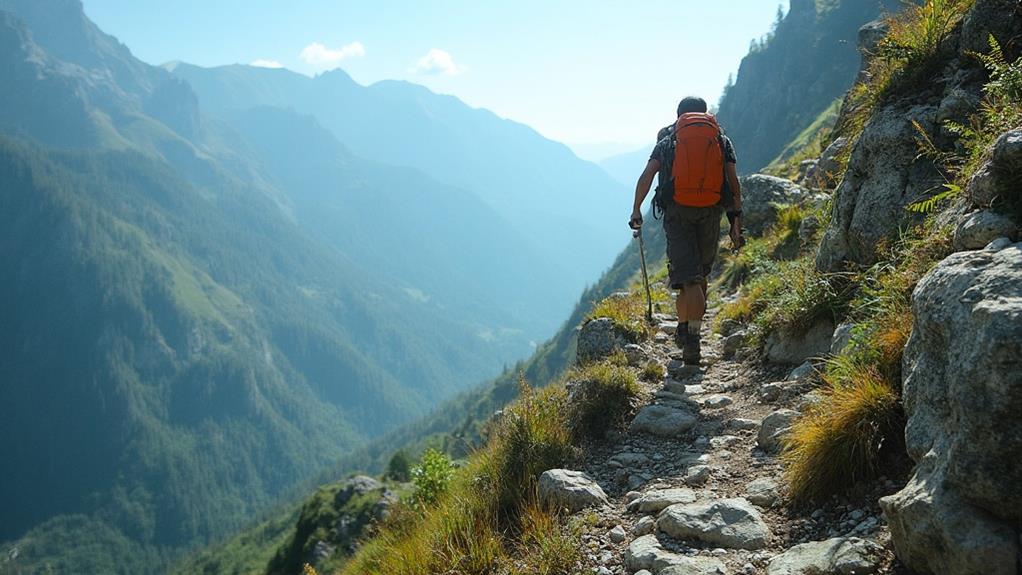
Mastering steep ascents requires a combination of efficient breathing techniques and a superior step strategy to guarantee both energy conservation and balance.
By focusing on steady inhalation and exhalation, hikers can better regulate their exertion levels, allowing for sustained performance on challenging inclines.
Additionally, employing the heel-to-toe walking technique with smaller, deliberate steps not only maintains momentum but also minimizes fatigue, making each climb more manageable and enjoyable.
Efficient Breathing Techniques
For many advanced hikers, mastering efficient breathing techniques during steep ascents can greatly enhance performance and endurance. Effective breath control is essential for optimizing oxygen efficiency, which can make the difference between a strenuous climb and an invigorating ascent.
Here are four key strategies to improve your breathing technique:
- Coordinate Breathing with Strides: Inhale for two to three steps and exhale for another two to three steps. This rhythmic pattern helps maintain a steady pace, ensuring that oxygen intake is maximized and energy expenditure balanced.
- Practice Diaphragmatic Breathing: Engage your diaphragm to take deeper breaths. This method increases oxygen intake, promoting better stamina and reducing fatigue, which is vital for tackling challenging uphill paths.
- Maintain a Consistent Pace: Adopting a slower, steady pace facilitates easier breathing and helps conserve energy. This allows you to focus on breath control without getting winded too quickly.
- Focus on Full Exhalation: Fully exhaling removes carbon dioxide buildup, preventing the onset of fatigue. Visualizing your breath flowing in and out like a wave can also aid in managing exertion levels, keeping you mentally focused on the climb.
Optimal Step Strategy
Having honed your breathing techniques to withstand the rigors of challenging climbs, it's time to focus on optimizing your step strategy to conquer steep ascents with confidence.
Mastering the art of step frequency and foot placement can greatly enhance your hiking efficiency and reduce fatigue. Begin with the heel-to-toe walking technique to maintain momentum and maximize energy use. This method allows for a smoother shift of weight and keeps your steps deliberate and stable.
On steep trails, smaller and more controlled steps are essential. This approach helps in conserving energy and maintaining balance, vital for long, demanding hikes. Visualizing the natural flow of water can aid in selecting your path; water often finds the less steep and more stable routes, which can inform your foot placement choices.
Engage your core muscles to lower your center of gravity, boosting your stability on uneven terrain. Synchronize your breathing with your steps, coordinating inhalations and exhalations with your movements to manage exertion and enhance endurance.
Navigating Steep Descents

While descending steep trails can be challenging, adopting the right techniques can guarantee safety and enhance your hiking experience. Mastering foot placement techniques and core engagement strategies is vital. By taking small, deliberate steps, you can maintain balance and reduce the risk of falling, which provides better control over foot placement.
Here are several tips to keep in mind:
- Core Engagement: Engage your core and lower your center of gravity to enhance stability. This helps absorb impacts and maintain proper posture throughout your descent.
- Utilize Hiking Poles: Hiking poles can offer additional support and stability, effectively reducing strain on your joints and giving you greater control as you navigate steep descents.
- Knee Flexion: To minimize impact on your knees, keep them bent and stay low, distributing weight evenly and absorbing shock better. This is vital in maintaining comfort and reducing fatigue.
- Perpendicular Stance: For safer foot placement, turn your body perpendicular to the slope on steep sections. This technique reduces the risk of slipping and guarantees more controlled movement.
Handling Uneven Terrain
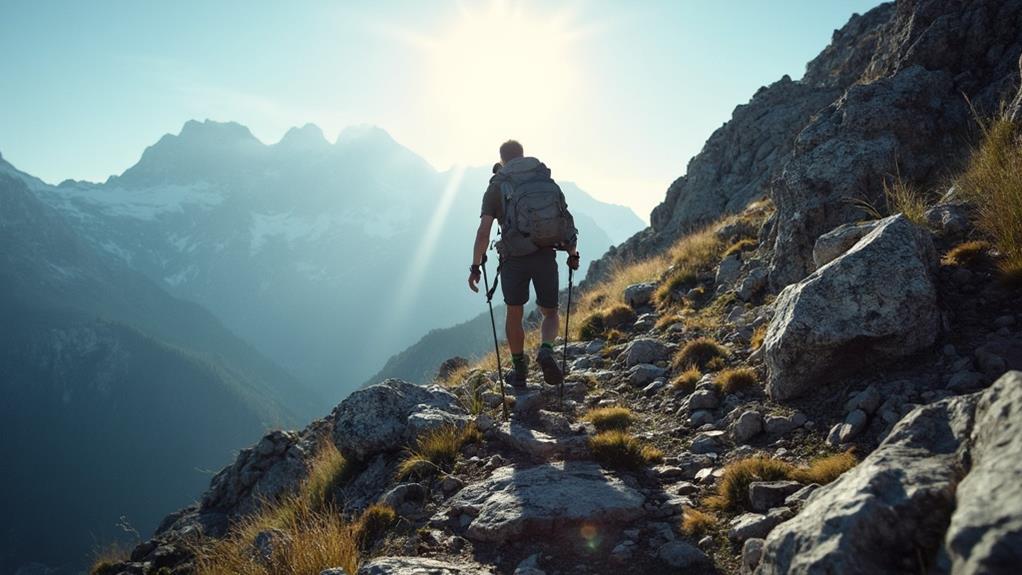
Maneuvering uneven terrain is an invigorating challenge that demands both physical endurance and strategic planning. Guiding such trails requires not only a heightened energy expenditure—approximately 28% more than flat surfaces—but also keen trail navigation skills and meticulous risk assessment to avoid mishaps. Uneven ground is notorious for concealing obstacles that can lead to rolled ankles and slips, making vigilance essential.
To tackle these challenges, adopting a cautious approach with small, deliberate steps enhances balance and stability, especially on rocky or bumpy sections. This technique allows hikers to maintain control and prevent accidents. Additionally, trekking poles become invaluable allies, providing extra support and stability. They aid in the distribution of weight, reducing strain on joints—a vital factor when energy and endurance are at a premium.
Equipping oneself with proper footwear is non-negotiable. Shoes designed for traction and support are essential to prevent injuries and guarantee comfort over long distances. This choice is a cornerstone of effective risk assessment, as it directly impacts the hiker's ability to safely and efficiently guide unpredictable terrain.
Ultimately, mastering uneven terrain enhances the hiking experience, offering both challenges and rewards to those prepared to meet them.
Manage Pace and Breaks

Successfully traversing uneven terrain sets the stage for another significant aspect of advanced hiking: managing pace and breaks. Effective pace management is essential for conserving energy and ensuring a successful hike. Here are some expert tips to enhance your hiking experience:
- Adjust Expectations: Recognize that on rugged terrain, your hiking speed may slow to 1 to 2 miles per hour. Adjust your expectations and pace accordingly to avoid overexertion.
- Establish Break Strategies: Taking regular breaks is vital for recovery and maintaining energy levels. Aim to rest every hour or every 2 miles, particularly on challenging trails, to prevent fatigue.
- Refuel Wisely: During these breaks, refuel with high-energy snacks like nuts and energy bars. Hydration is equally important to sustain endurance and keep your body functioning effectively throughout the hike.
- Consistent Pacing: Avoid sudden bursts of speed to minimize early fatigue risks. Maintain a consistent pace that aligns with your fitness level and the trail's difficulty, adapting to steeper sections with slower, deliberate movements.
Boulder Field Strategies
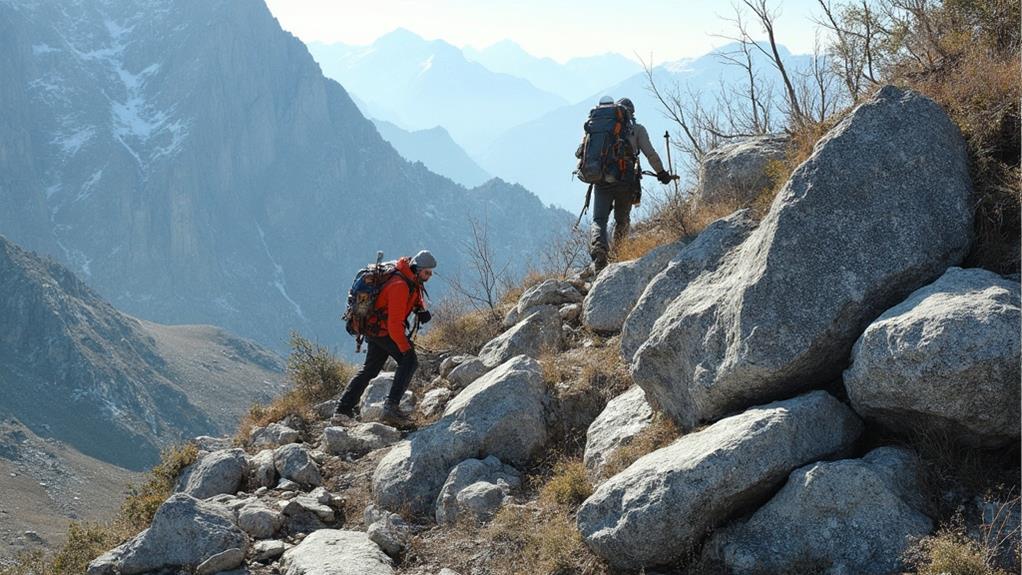
Traversing boulder fields presents a unique set of challenges that require focus and skill. These rugged terrains demand precise boulder navigation techniques to guarantee safety and progress. As you initiate these sections, prioritizing your footing is essential to prevent slips and falls, given the treacherous nature of uneven surfaces.
A practical approach involves using topographic maps and cairns to guide your path, as boulder fields often lack clear trail markers. Maintaining a low center of gravity is vital for balance and stability. Engage your core and take small, deliberate steps, which not only enhance your stability but also help conserve energy—important given that boulder fields can increase hike difficulty by up to 28%.
Beyond balance, conducting a rock stability assessment before stepping on each boulder is necessary. Loose rocks can cause tumbles, so always test their firmness with a gentle nudge or weight shift before committing.
The energy and focus required in these environments heighten the overall hiking challenge, but with meticulous preparation and the right techniques, you can navigate boulder fields effectively and safely, turning a potentially intimidating task into a rewarding adventure.
Safe River Crossings
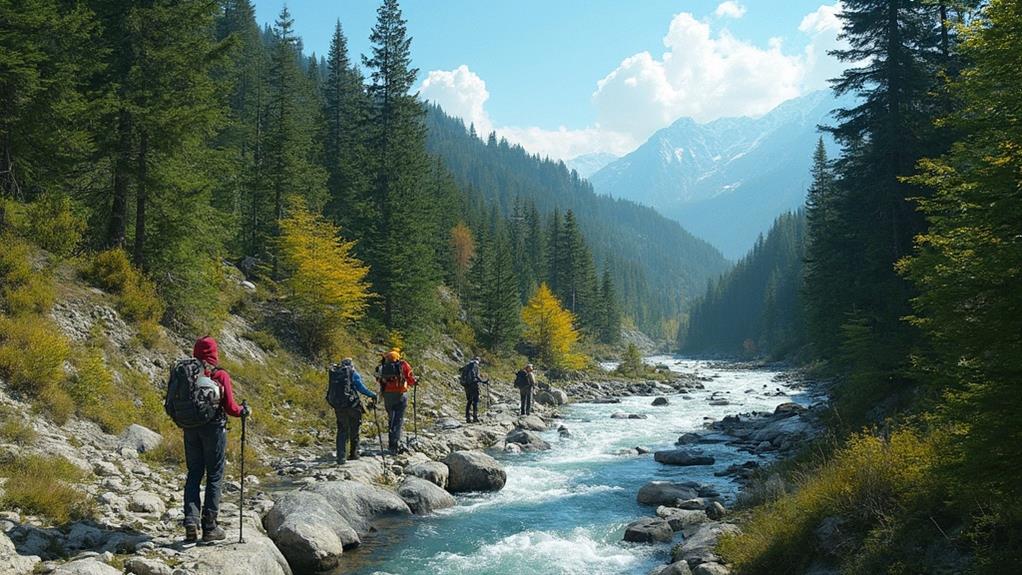
When faced with the challenge of river crossings during a hike, preparation and technique are vital for ensuring a safe passage. River safety should always be at the forefront of an advanced hiker's mind. Implementing effective crossing techniques can greatly reduce the risk of accidents.
Here are four essential strategies to keep in mind:
- Select Designated Crossing Areas: Always opt for marked shallow sections or logs that are specifically designated for crossings. These areas are often chosen for their lower risk, providing a safer path across the river.
- Assess Footing Stability: Before committing to a crossing, test any rocks or logs for stability. Ensuring they can support your weight without slipping is important to prevent falls and maintain balance.
- Keep Boots On: Wearing your boots while crossing protects your feet from sharp rocks and submerged snags, reducing the chance of injury.
- Unbuckle Backpack Straps: Before entering the water, unbuckle your backpack straps. This precaution allows you to quickly shed the pack if you lose balance, enhancing your safety in unexpected situations.
Adhering to these river safety guidelines and crossing techniques will bolster your confidence and security, ensuring a successful hike across challenging terrains.
Rock Scrambling Safety
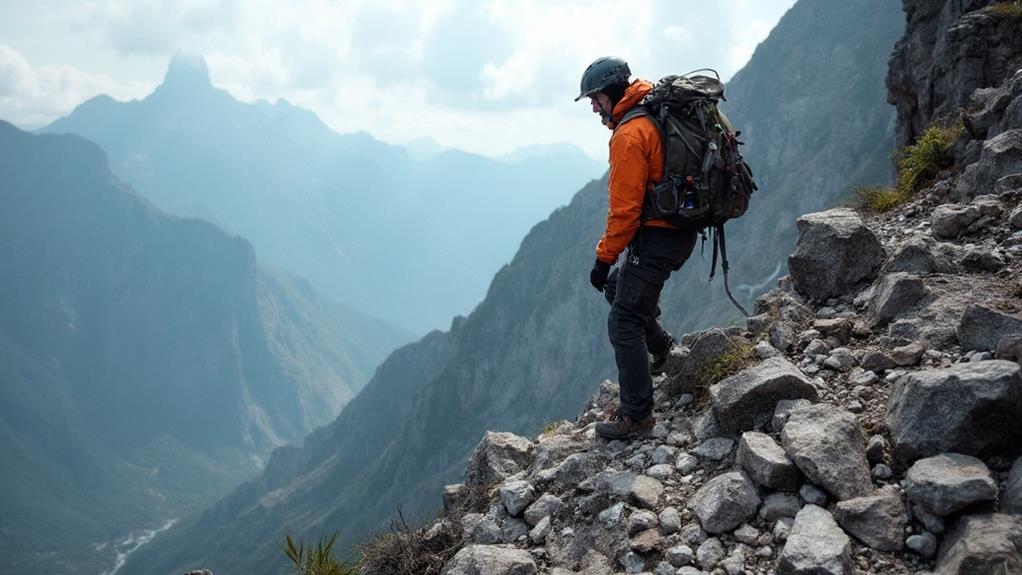
In the exhilarating world of rock scrambling, maintaining three points of contact—either two hands and one foot or two feet and one hand—is essential for ensuring balance and stability on uneven surfaces.
Selecting the most stable and least steep routes is a strategic measure to reduce the risk of slips and falls, especially when maneuvering loose rocks.
This approach not only enhances safety but also enriches the hiking experience by allowing adventurers to focus more on the thrill of the climb and less on potential hazards.
Maintain Three Points Contact
Mastering the art of rock scrambling requires a keen understanding of safety techniques, with maintaining three points of contact standing as a fundamental practice. This approach involves having either two hands and one foot or two feet and one hand firmly engaged with the rock surface. By adhering to this principle, you can enhance grip stability and achieve a balanced posture, essential for maneuvering uneven or loose surfaces without incident.
Here are some important techniques to take into account:
- Balance Techniques: Distributing your weight evenly across your contact points helps manage your center of gravity, greatly reducing the risk of slips or falls.
- Grip Stability: Prioritize choosing solid and secure hand and foot placements. Avoid using vegetation or fragile rocks, as they may not provide the necessary support.
- Core Engagement: Actively engage your core muscles to maintain control and fluidity in your movements, particularly during challenging ascents and descents.
- Confidence Building: Regular practice of maintaining three points of contact increases your confidence and efficiency, enhancing your ability to tackle complex terrains safely.
Ultimately, integrating these methods into your rock scrambling routine can transform your hiking experience, making it safer and more rewarding.
Choose Stable Routes
Building on the foundation of maintaining three points of contact, selecting stable routes is essential for ensuring safety during rock scrambling. Route evaluation involves more than just identifying the quickest path; it requires a careful terrain assessment to choose routes with the least steep and most stable features. Opting for such routes considerably reduces the risk of slips and falls, allowing for a safer ascent.
During terrain assessment, prioritize solid rock features over vegetation, as the latter can be unreliable and cause ecological damage. By focusing on placing your feet carefully on stable holds, you maintain a lower center of gravity, which enhances balance and control. This technique is especially vital when tackling more challenging scrambles, graded from Class 2 to Class 4. Familiarizing yourself with these classifications helps match your skill level to the appropriate difficulty, ensuring both safety and enjoyment.
Moreover, keeping your body low to the ground not only aids in stability but also in quick adaptability, should the terrain suddenly shift. By integrating these strategies, advanced hikers can confidently navigate tough terrains, turning potential hazards into thrilling and rewarding experiences.
Beach and Snow Challenges

Steering through the diverse challenges of beach and snow terrains requires both preparation and adaptability for the seasoned hiker. Mastery over these unique environments begins with an acute sense of tide awareness and snowpack evaluation.
Coastal hikes demand vigilance; tides can transform routes into perilous passages. Consequently, consulting tide charts is essential to prevent being stranded or overwhelmed by surging waters. Likewise, in snowy landscapes, evaluating snowpack stability is vital to avoid avalanches and guarantee a secure trek.
Here's a strategic approach to tackle these terrains:
- Tide Awareness: Prioritize checking tide schedules before venturing out on coastal trails to guarantee safe passage and timing.
- Energy Management: Walking on sand or pebbles requires significant exertion. Adjust your pace to manage fatigue, conserving energy for longer hikes.
- Equipment Utilization: Employ hiking poles for enhanced stability and balance on sandy or loose surfaces, minimizing strain on joints.
- Snowpack Evaluation: Ensure you're equipped with proper gear like microspikes or crampons to maintain traction and safety on snow-covered paths.
Enhance Outdoor Skills
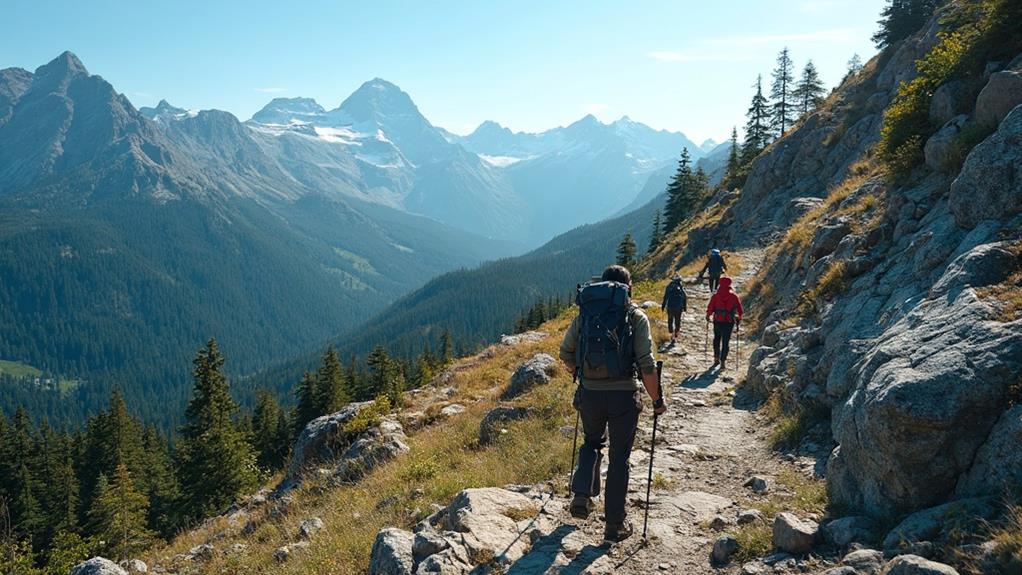
Developing a thorough set of outdoor skills is essential for hikers looking to conquer challenging terrains with confidence and safety. A critical aspect of skill development involves mastering navigation techniques, such as reading topographic maps and utilizing GPS devices. This knowledge allows hikers to effectively manage difficult landscapes, including boulder fields and steep descents, by making informed decisions on route selection and orientation.
To further enhance outdoor capabilities, hikers should focus on advanced hiking skills like rock scrambling and managing river crossings. These can be honed by gradually increasing difficulty in a controlled environment, providing a solid foundation before tackling more formidable hikes.
Investing time in physical conditioning is equally important; strength training, balance exercises, and endurance workouts are crucial to navigate uneven terrain efficiently.
Using trekking poles can greatly aid in maintaining stability and reducing joint strain, especially on challenging surfaces or steep inclines. Engaging in outdoor skill development through guided trips or workshops can also provide valuable insights into terrain navigation and emergency preparedness.
Frequently Asked Questions
What Makes an Advanced Hiker?
An advanced hiker is characterized by exceptional physical fitness, technical skills, and navigation expertise. They adeptly handle challenging terrains, employ specialized gear for safety, and uphold wilderness safety standards, demonstrating a commitment to environmental stewardship and trail etiquette.
How Do You Build Mental Toughness for Hiking?
Building mental toughness for hiking involves employing visualization techniques and resilience training. Visualizing success on challenging trails enhances mental preparedness, while resilience training, through physical endurance and positive self-talk, strengthens psychological fortitude for demanding hiking scenarios.
What Makes Someone an Experienced Hiker?
An experienced hiker demonstrates proficiency in gear selection, ensuring ideal comfort and safety, and excels in trail navigation, skillfully tackling challenging terrains. Their expertise encompasses understanding environmental conditions and maintaining preparedness with essential supplies and navigational tools.
What Elevation Gain Is Considered Difficult?
Elevation challenges become particularly difficult with a gain exceeding 1,500 feet, especially on trails with steep ascents. Advanced trails often classify a cumulative elevation gain over 3,000 feet as extremely hard, emphasizing the need for substantial physical endurance.
Conclusion
Advanced hiking in challenging terrains demands thorough preparation and skillful execution. By diligently researching trail conditions and selecting appropriate gear, hikers can optimize safety and performance. Engaging in targeted practice hikes and cross-training enhances physical readiness, while efficient backpack packing guarantees essentials are accessible. Mastery of techniques for safe river crossings and rock scrambling, along with strategies for traversing beach and snow environments, further fortify one's capabilities. Continuous enhancement of outdoor skills remains essential for tackling diverse and demanding landscapes.